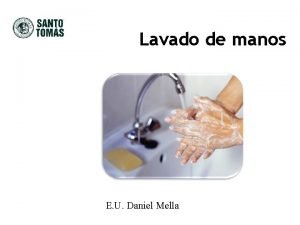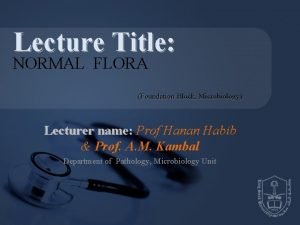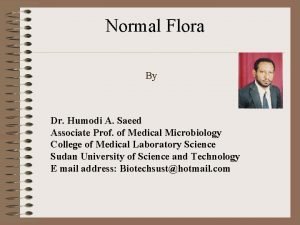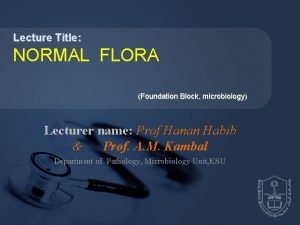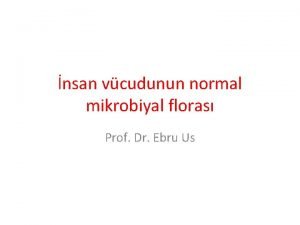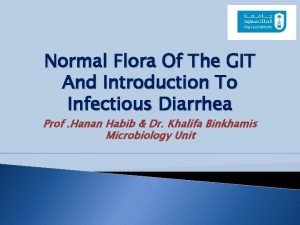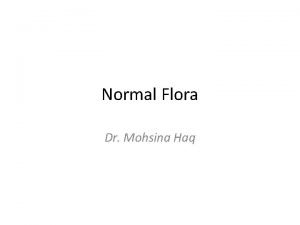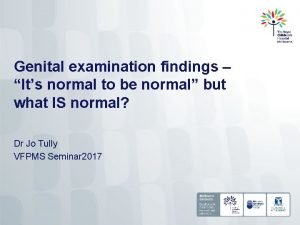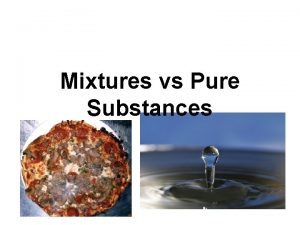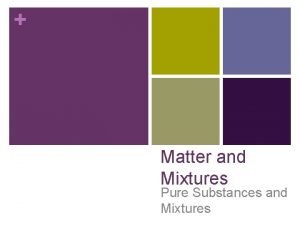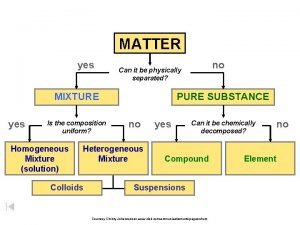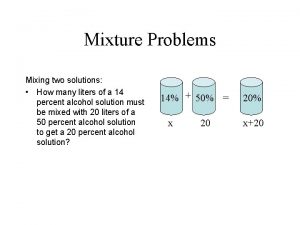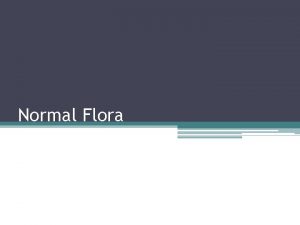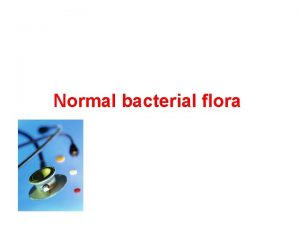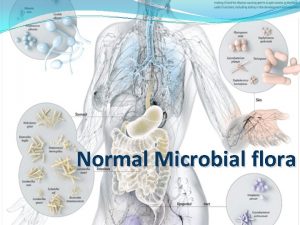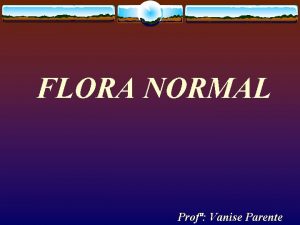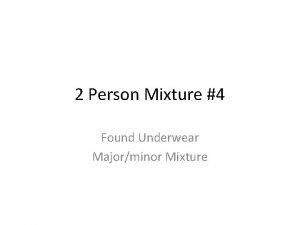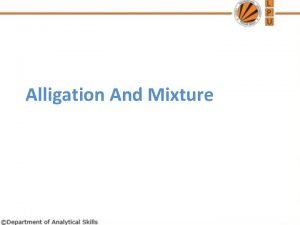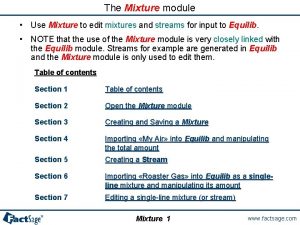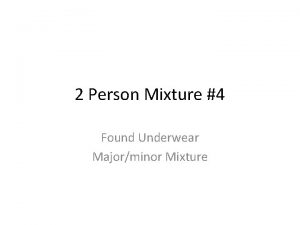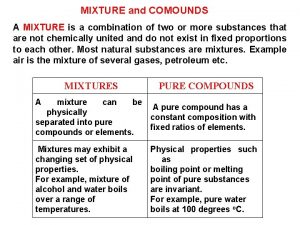Normal Flora What is Normal Flora mixture of


































- Slides: 34

Normal Flora

What is Normal Flora ? mixture of microorganisms regularly found at any anatomical site on /within the body of a healthy person. Some are found in association with humans / animals only. Others are found in the environment as well.

Resident vs. Transient flora • Resident populations (normal flora, microbiota, indigenous microbial population, microflora, microbial flora) • Vast majority of normal flora are bacteria. • Internal tissues normally sterile

Terms • Carriers: carry the pathogen but are asymptomatic • Convalescent carriers • Permanent carriers---- asymptomatic---reservoir of infection • Colonization------new organism acquired-----either asymptomatic-------or can become symptomatic if not eliminated by host defenses • Colonization a stage before full fledged infection acquizition

Symbionts • Symbiosis: living together of two dissimilar organisms – Optional or obligatory – Temporary or permanent – Entosymbiosis – Ectosymbiosisides • Symbiotic relationships – Commensalism – Mutualism – Parasitism – Amensalism – Synnecrosis

B. What are The Roles Of Normal Flora: 1. May be source of opportunistic infections e. g. In-patients with impaired defense Mechanisms. 2. Immunostimulation a) They produce antibodies which may contribute to host defenses. b) Some of these antibodies may cross react with normal tissue components.

3) Protection from External Invaders normal flora occupy body’s epithelial surfaces, they prevent other bacteria from establishing by blocking receptors (attachment), competing for essential nutrients or producing anti-bacterial substancese. g. Fatty acids, peroxides , Bacteriocins. 4) Nutrition E. coli & Bacteroids produce Vitamin K in the gut which is available for use by host.

5) Production of Carcinogens Some normal flora may modify, through their enzymes, some chemicals in our diets into carcinogens e. g. Artificial sweeteners may be enzymatically modified into bladder carcinogens. 6) Stimulate development of certain tissues: Caecum and lymphatic tissues (Peyer’s patches) in GI tract and influence immunology of gut-associated lymphatics

Normal flora • Human body cells/gm/sq cm of skin – 1013 cells – 1014 bacteria

Normal flora • Some bacteria occupy more than one niche – Skin, conjunctiva, nose, pharynx, mouth, lower intestine, anterior urethra, vagina – Staphylococcus epidermidis, Staphylococcus aureus, Corynebacterium spp

Normal flora • Some bacteria occupy only one niche: tissue tropism • • • BACTERIUM TISSUE Corynebacterium diphtheriae Throat Streptococcus mutans Tooth surfaces Streptococcus salivarius Tongue surfaces Vibrio cholerae Small intestine epithelium • Tropism determined by bacterial ligand-host receptor interactions • Variation in microflora at one site age sex, diet • Combinations of microflora at same site GIT

Normal flora - Skin • Human adult has 2 square meters of skin – Overall, a hostile environment toward bacteria – Periodic drying – Eccrine (simple sweat) glands – Apocrine glands: sweat and nutrients – Sebaceous glands: associated with hair follicles • Transient microbes: in contact with environment • Resident microbes

Normal flora - Skin • Skin: 3 main microenvironments – Axilla, perineum, toe webs – Hands, face and trunk – Upper arms and legs • S. epidermidis – Major inhabitant making more than 90% of the flora • S. aureus – Nose, perineum, vulvar skin – in nasal passages varies with age being greatest in newborns, less in adults • Micrococci, Diphtheroids, Propionibacterium – eg. P. acnes = children younger than 10 years are rarely colonized with it

Normal flora - Skin • Neither profuse sweating nor washing significantly modifies normal skin flora – Soap or disinfectant (hexachlorophene) diminish microbial population – But normal flora rapidly replenished from sebaceous and sweat glands • Pathogenic organisms eliminated

Normal flora - Conjunctiva • Variety of bacteria: low numbers present – High moisture – Blinking mechanically removes bacteria – Lachrymal secretions include lysozyme

Normal flora - Respiratory tract • Nostrils: – Staph spp , coryne • Nasopharynx : – α and β Strep – Neisseria spp. , Haemophilus influenzae • Oropharynx: – Staph spp, coryne – α Strep, Neisseria spp

Normal flora - Respiratory tract • Lower respiratory tract (trachea, bronchi, pulmonary tissues) – Usually sterile – Ciliated epithelium – Mucus blanket: entrapment – Alveolar macrophages – If breached: opportunistic infections

Normal flora - Oral cavity • Ecology and developmental stages – Birth: sterile mouth within 4 -12 hours (lactobacilli, streptococci) – Neonate (Streptococcus salivarius, staphylococci, Neisseriae, Moraxella catarrhalis – Teeth appear (Streptococcus mutans, Streptococcus parasanguis) – Gingival crevice area (Anaerobic species, yeasts) – Puberty (Bacteroides, spirochetes) • 108 bacteria/m. L of saliva; potentially >700 species

Normal flora - Gastrointestinal tract • Ecology – Birth: sterile – Breast-fed Bifidobacteria species – Switch to cow’s milk Enteric, bacteroides, enterococci, lactobacilli and clostridia – Switch to solid food • Microflora similar to parents

Normal flora - Gastrointestinal tract • • GI ecology varies Esophagus saliva , food Stomach harsh 10 Small intestine (103 -108) – Proximal small intestine (duodenum and jejunum) – Distal small intestine (ileum) • Large intestine – 109 -1011/ml – >350 species • E. coli = 0. 1% of total population – Primarily anaerobic • Facultative aerobes deplete oxygen – Adult excretes 3 x 1013 bacteria/day • 25%-35% of fecal mass = bacteria

Normal flora - Gastrointestinal tract Location (adult) Bacteria/gram contents duodenum 103 -106 jejunum and ileum 105 -108 cecum and transverse colon 108 -1010 sigmoid colon and rectum 1011

Normal flora - Urogenital tract • Upper urinary tract (kidneys, ureters, bladder) usually sterile • Male anterior urethra Same as skin +enteric+enterococcus • Vagina: complex microbiota – At birth Same as mother (PH 5) – Neonate Same as skin+enteric+ strept (PH 7) – At puberty Lactobacillus+same as skin+anaerobes+strep (PH 5) – At menopause: return to prepuberty flora

Sputum Sample

Vaginal Flora

Urethritis

Bacterial-human relationships – Normal flora – Opportunistic infections – Pathogenic infections

Normal flora - Risks • Dental plaque • Dental caries: destruction of enamel, dentin or cementum of teeth • Periodontal disease • Inflammatory bowel disease • Obesity

Opportunistic flora • Some normal flora become opportunistic pathogens • (Staphylococcus aureus, Streptococcus mutans, Enterococcus faecalis, Streptococcus pneumoniae, Pseudomonas aeruginosa, etc. ) • Breach of skin/mucosal barrier: trauma, surgery, burns • Bacterium at one site may be commensal, but might be pathogenic at another site

Mouth flora

Opportunistic flora • Growth of commensals may put patient at risk – Broad-spectrum antibiotic therapy decreases total number of bacterial in gut • During repopulation, faster-growing aerobic Enterobacteriaceae over slower-replicating anaerobes increases probability of gram-negative bacteremia – Cross-reactive responses to host tissue: Superantigen – Chronic, low-grade inflammation • Perturbation of cytokine network

Gastrointestinal flora • Antibiotics overuse • Antibiotic associated diarrhae • C. dfficile -associated diarrhea (CDAD) • Pseudomembranous colitis – toxic megacolon

Normal flora - Risks and Opportunistic Clinical conditions that may be caused by members of the normal flora

Probiotics/Prebiotics • Probiotic – Oral administration of living organisms to promote health – Mechanism speculative: competition with other bacteria; stimulation of nonspecific immunity – Species specific: adherence and growth (tropism) • Prebiotic – Non-digestible food that stimulates growth or activity of GI microbiota, especially bifidobacteria and lactobacillus bacteria (both of which are noninflammatory) – Typically a carbohydrate: soluble fiber

Gnotobiology • Gnotobiotic animals: “germfree” (axenic) – Fetus is sterile • Cesarean sections to obtain fetus • Fetus growing in sterile isolator • Not anatomically or physiologically normal – Poorly developed lymphoid system, thin intestinal wall, enlarged cecum, low antibody titers – Die of intestinal atonia ( motility problem) – Require vitamin K and B complexes – No dental caries or plaque • More susceptible to pathogens
 Is 14 karat gold homogeneous or heterogeneous
Is 14 karat gold homogeneous or heterogeneous Lavado de manos clinico
Lavado de manos clinico Zona sur fauna
Zona sur fauna Definition of normal flora
Definition of normal flora Normal flora of respiratory tract
Normal flora of respiratory tract Definition of normal flora
Definition of normal flora Ear flora
Ear flora Normal flora definition
Normal flora definition Normal mikrobiyal flora içeren vücut bölgeleri
Normal mikrobiyal flora içeren vücut bölgeleri Diarrhea introduction
Diarrhea introduction Normal flora of oral cavity
Normal flora of oral cavity Haky11 xxx
Haky11 xxx Hymen
Hymen Properties of matter and materials grade 7
Properties of matter and materials grade 7 Training gaussian mixture models at scale via coresets
Training gaussian mixture models at scale via coresets Is gatorade a heterogeneous mixture
Is gatorade a heterogeneous mixture Is jelly beans an element compound or mixture
Is jelly beans an element compound or mixture Matter flowchart
Matter flowchart Is cake batter homogeneous or heterogeneous
Is cake batter homogeneous or heterogeneous How to solve mixture word problems
How to solve mixture word problems Is italian dressing an element compound or mixture
Is italian dressing an element compound or mixture Is a pizza a heterogeneous mixture
Is a pizza a heterogeneous mixture Critical solution temperature definition
Critical solution temperature definition Compounds vs mixtures
Compounds vs mixtures Iv admixture definition
Iv admixture definition Homogeneous mixture vinegar
Homogeneous mixture vinegar Cake mixture quantities for different sized tins
Cake mixture quantities for different sized tins Carbonic acid is a mixture of brainpop
Carbonic acid is a mixture of brainpop Density of mixture formula
Density of mixture formula How to write a name poem
How to write a name poem Jeopardy solutions
Jeopardy solutions Atomic-scale view of a mixture
Atomic-scale view of a mixture Chapter 14 mixtures and solutions worksheet answers
Chapter 14 mixtures and solutions worksheet answers Evaporation separating mixtures
Evaporation separating mixtures A 5 gallon radiator containing a mixture of water
A 5 gallon radiator containing a mixture of water

